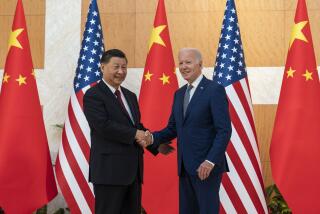Coca-Cola’s Growth Upsets Chinese Lawmakers : Trade: Some legislators seek to limit market share of the company, growing in China at 30% a year.
- Share via
BEIJING — Legislators of the National People’s Congress, China’s parliament, which concluded a session over the weekend, have raised protectionist cries over foreign domination of the local soft-drink market.
Foreign brands, notably Coca-Cola, are proving too successful, they said, in a fragmented market with a dearth of national brands.
Thirty-two NPC deputies submitted a motion, which was not taken up the session, asking the authorities to “appropriately restrict” the expansion of Coca-Cola and Pepsi Cola in China. “We should protect traditional beverages and help them get on their feet . . . market share of Coca-Cola and Pepsi is too big,” said Chen Bixia, a representative from China’s southern Guangdong province.
China has become Coca-Cola’s fastest-growing overseas market. Last month, the company said cola sales in China climbed 76% in 1994.
In 1994, Coca-Cola sold the equivalent of 136 million 24-bottle cases of soft drink, including Coca-Cola, Sprite and Fanta. These brands now account for 18% of China’s beverage market and are continuing to increase their market share.
Steve Chan, general manager of Coca-Cola China, sees no reason why the company should not continue its growth of 30%-35% a year to the year 2000, when China would account for significantly more than the present 1% of Coca-Cola’s worldwide sales.
“China will definitely become much more important and represent a larger percentage of Coca-Cola sales,” Chan says. “In a market of 1.2 billion, a lot of people will become more affluent and have more disposable income.”
Helena Coles, a consumer products strategist with Kleinwort Benson in Hong Kong, has a rosy outlook on Coca-Cola in China. “The beverage market in China grows by as much as increases in capacity will allow,” she says. “People like Coca-Cola have the money and know-how to keep increasing capacity, unlike the local players, who lack the funds and expertise.”
When Coca-Cola re-entered China in 1979 at the dawn of the “open door” policy, it did not prove an immediate success. To the Chinese palate it tasted like herbal medicine, but sales growth is now climbing in line with a successful strategy of appealing to younger, affluent consumers.
In 1994, sales of Sprite and Fanta accounted for about 56%, with Coke sales at 37%. But Coca-Cola is forecast soon to outsell its stablemates in China, as in most other markets.
Coca-Cola’s continuing assault on the Chinese market includes plans for 10 new bottling plants by 1996 in addition to the existing 13. This will bring its investment in China to about $500 million.
Strategy provides for pushing further inland, with new plants to be opened this year in Wuhan, central China, Shenyang and Harbin in the northeast and Xian in the northwest. Most existing bottling facilities are in coastal cities such as Shanghai, Hangzhou, Xiamen, Guangzhou, Zhuhai and Hainan island.
“Our strategy of moving inland does not mean, however, that we will not continue growing our business in existing locations,” says Chan. “The large urban areas are still very important to us, but we need to move inland as China’s economic development spreads inward.”
Coca-Cola’s partners in the Chinese ventures are the Hong Kong-based Swire and Kerry groups. Of the 10 new franchises, Kerry will be responsible for seven and Swire for three in joint-venture partnerships with local Chinese entities.
Among Chinese partners are China International Trust and Investment Corp., China National Council of Light Industry and China National Cereals, Oil and Foodstuffs Import and Export Corp.
Coca-Cola’s strategy is to take a 12.5% share in these ventures, which are run by Kerry Beverages and Swire Beverages respectively. The American company supplies concentrates used in China from a wholly owned plant established in Shanghai in 1988 and known as Shanghai Shenmei Food and Beverages.
But with the enormous growth in Coca-Cola sales, either the concentrates plant will require expansion or a second factory will be needed. No decision has been made.
Chan says the company is not only seeking to grow with the increase in demand among affluent consumers but is also endeavoring to “drive demand.” Its marketing strategy is aimed primarily at “making the products as available as possible.” This is not easy in China, where transport is chaotic, but Coca-Cola and its partners seek, he says, to “aggressively use a direct distribution network.” They also use wholesalers to augment direct sales and distribution.
The company must be doing something right. It outsells Pepsi Cola 3 to 1, according to its own estimates. Local competitors pose little threat to its expansion plans and unlike other U.S. brands Coca-Cola has avoided the counterfeiting scourge.
More to Read
Inside the business of entertainment
The Wide Shot brings you news, analysis and insights on everything from streaming wars to production — and what it all means for the future.
You may occasionally receive promotional content from the Los Angeles Times.









